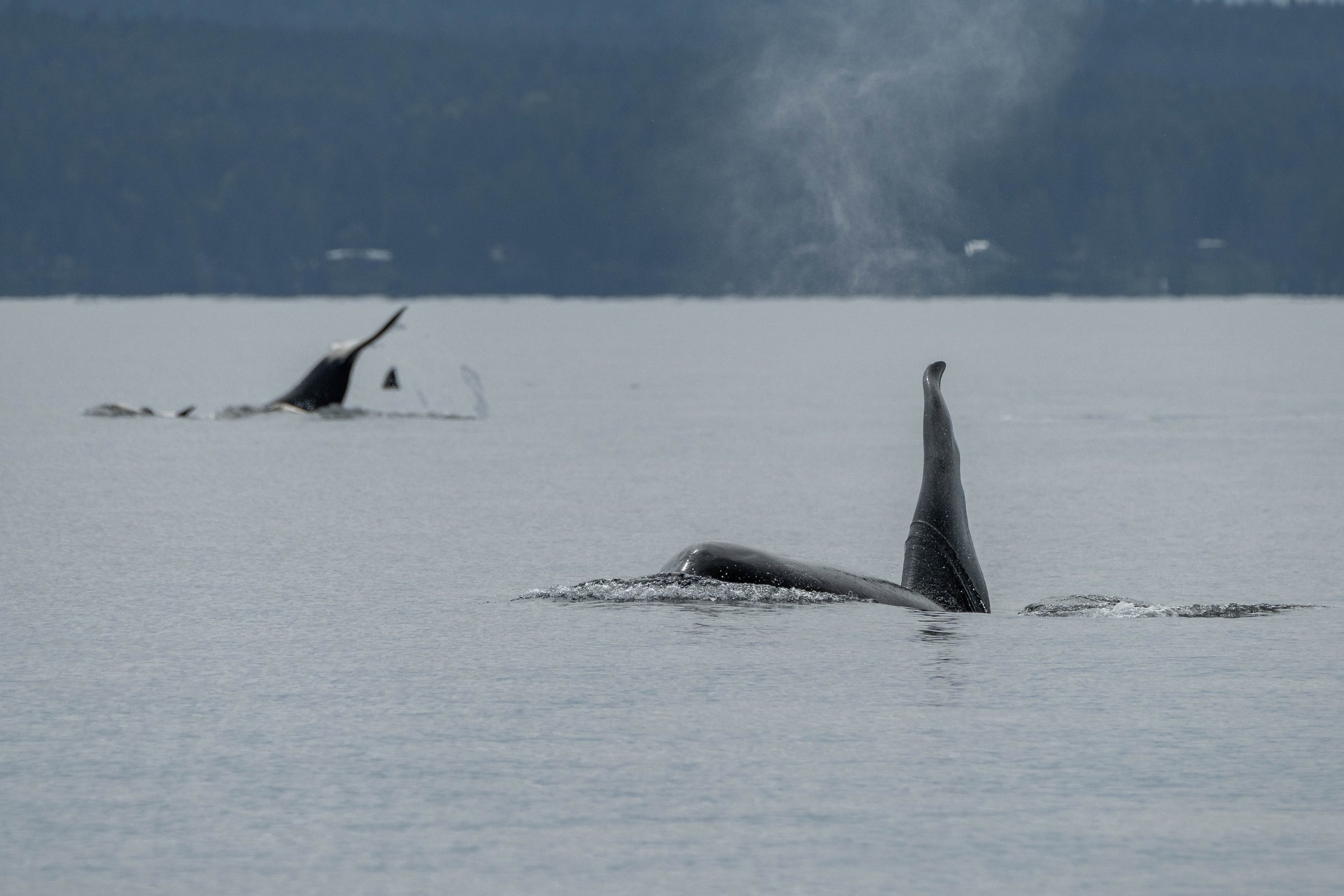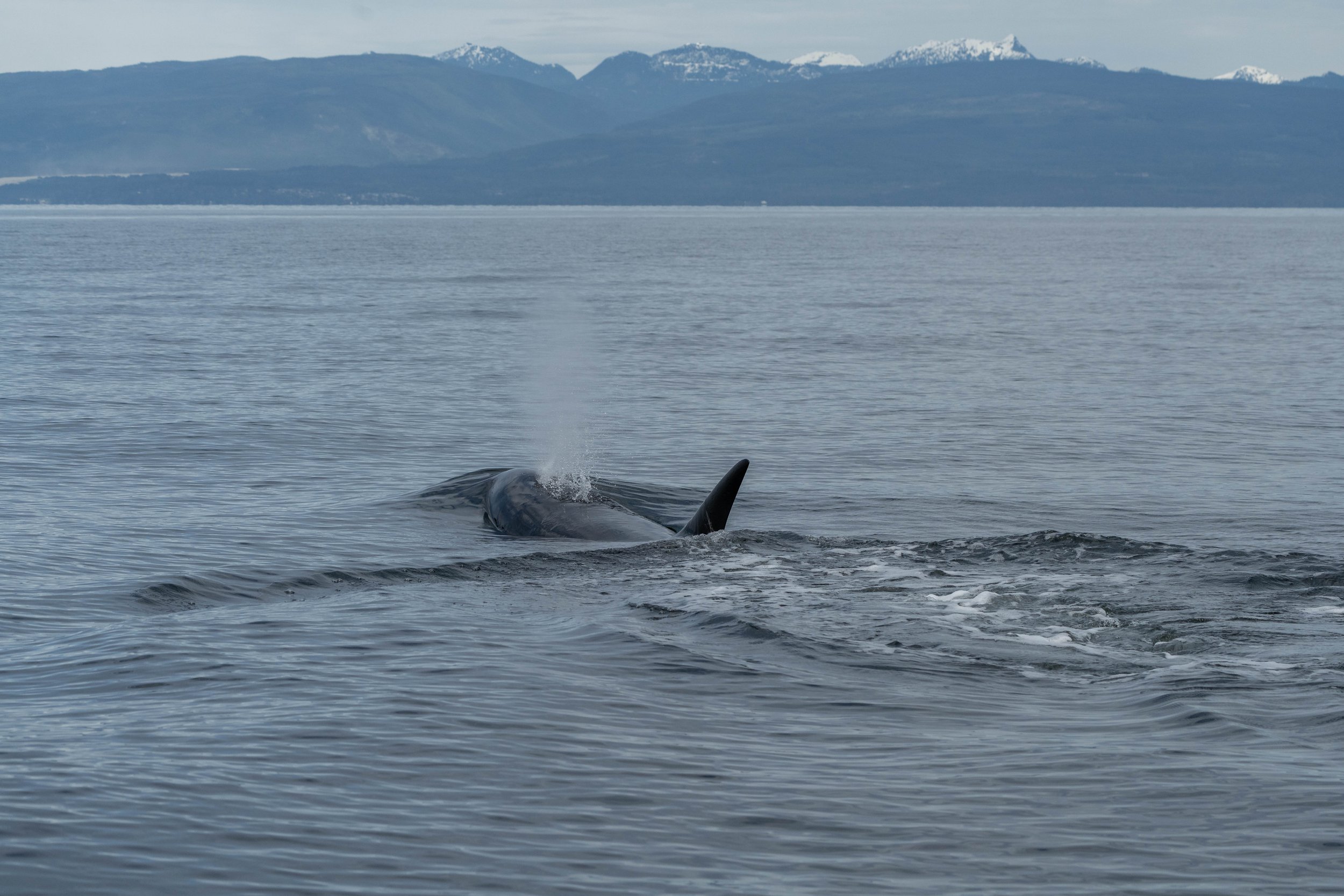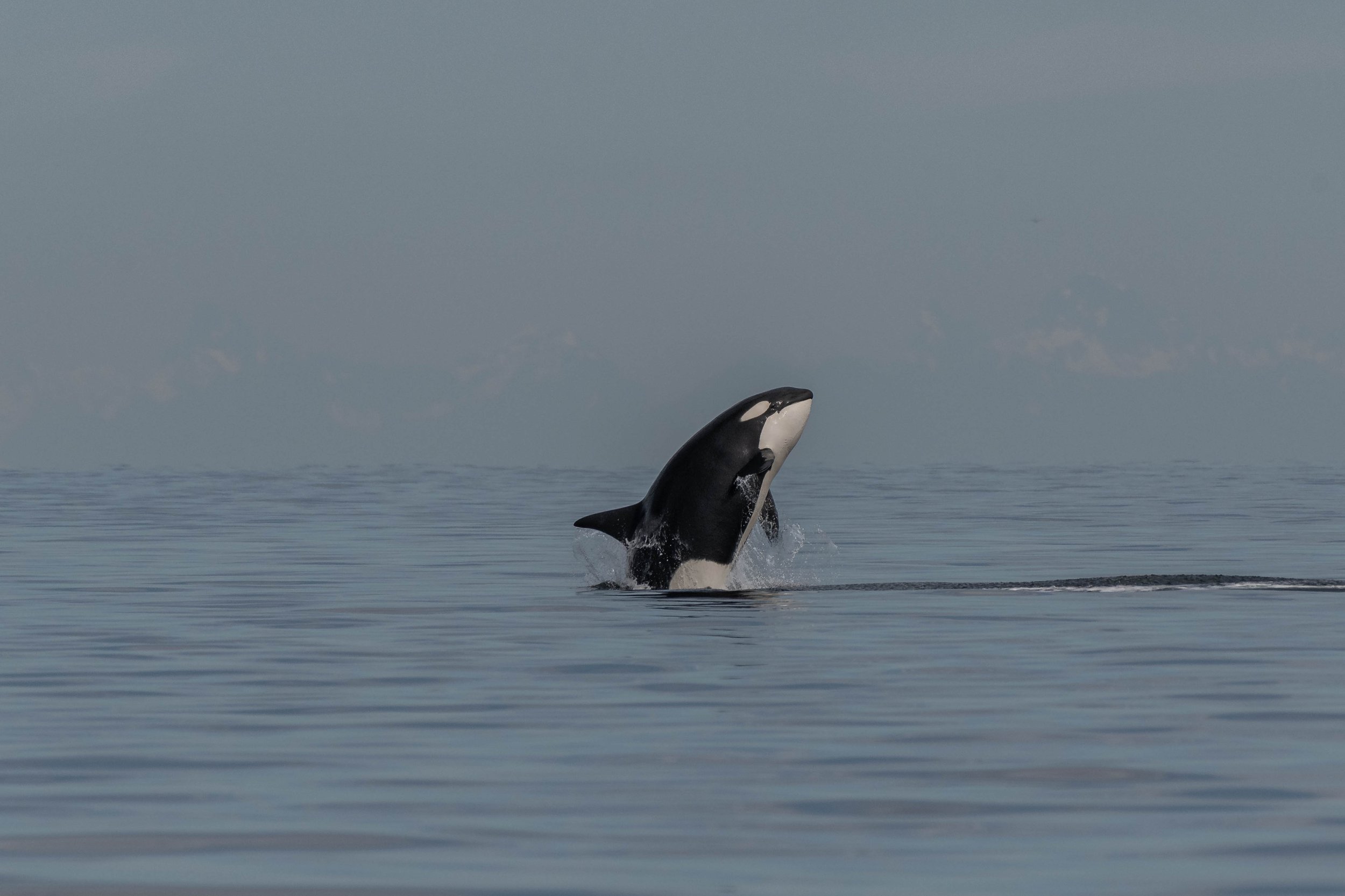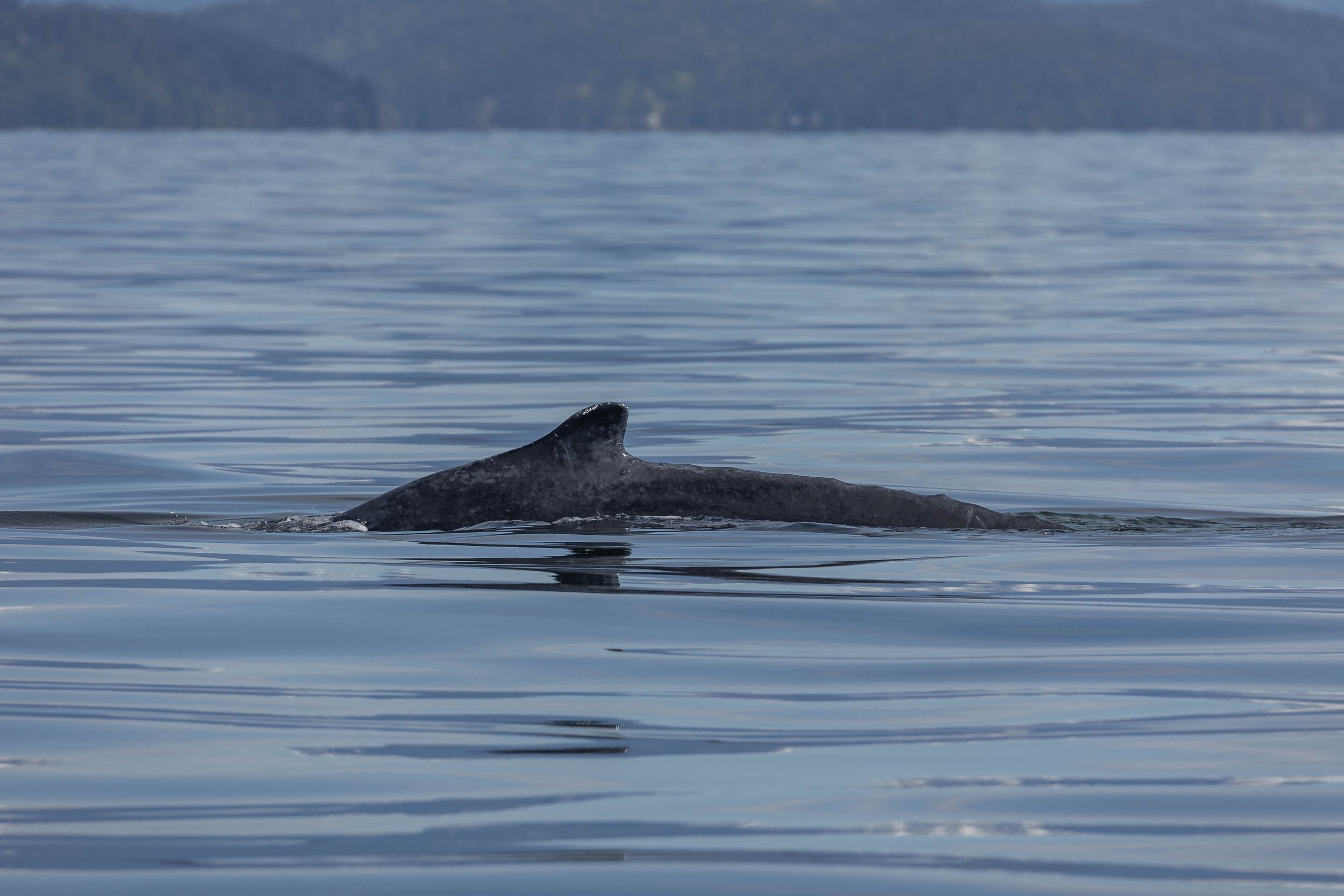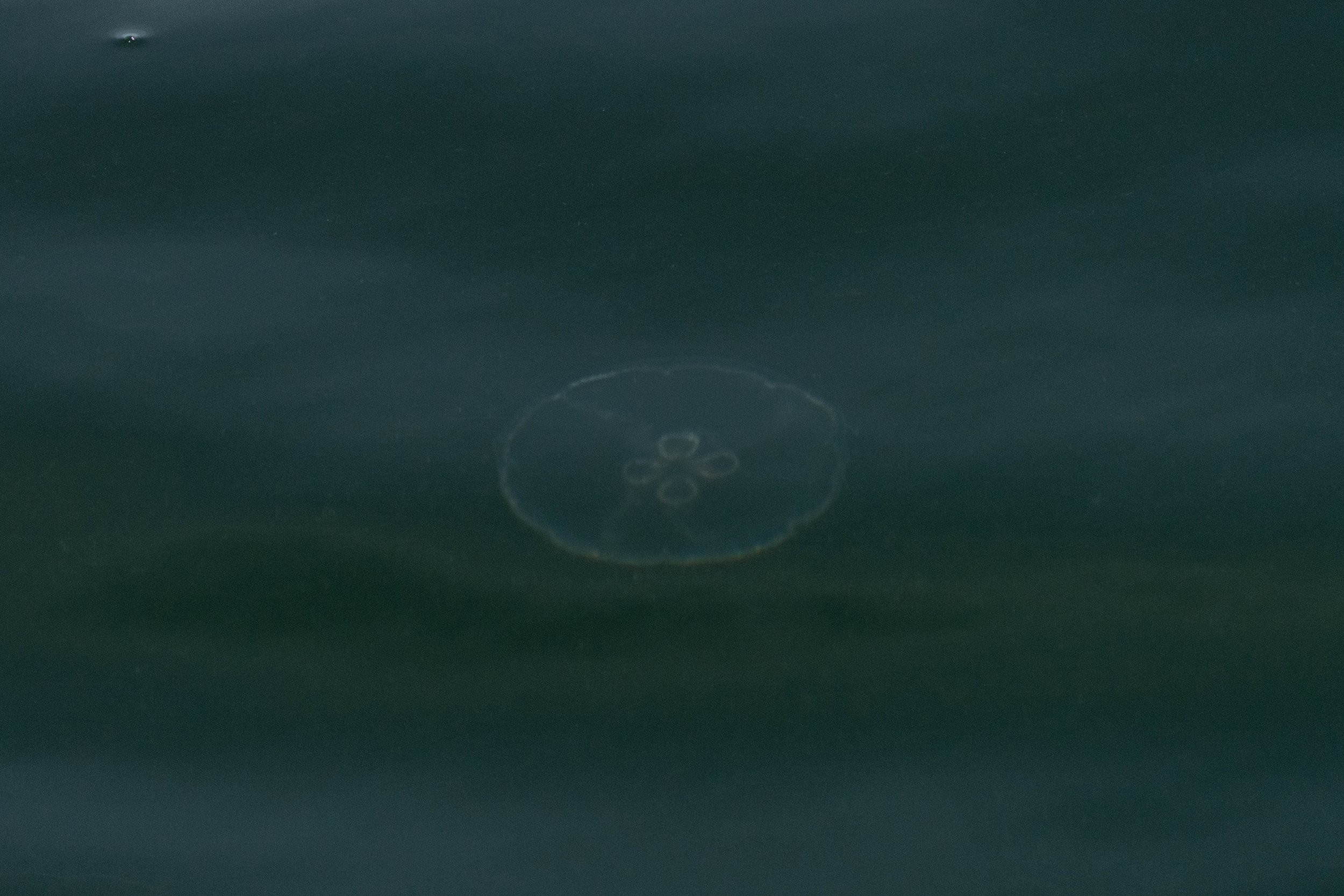May 5, 2025 - Our First Double-Species Day of the Season!
It was a beautiful, sunny day as we had all three of our vessels push off the dock and head out into the Salish Sea to find out what was in store for us today. Not only did today end up being our first double species day of the season, but it felt like a whale-sized party was being thrown in our honour.
This excitement started out with two different encounters with whales by each of our boat types, with the semi-covered boat, Kula, finding a pair of orca travelling together in Northumberland. These two whales turned out to be the wayward T049A brothers, Noah and JudeIt was a beautiful, sunny day as all three of our vessels pushed off the dock and set out into the Salish Sea to discover what surprises awaited us. Not only did the day turn out to be our first double species encounter of the season, but it felt like a whale-sized party was being thrown in our honour.
The excitement began with two separate whale encounters, each experienced by a different boat type. The semi-covered boat, Kula, found a pair of orcas travelling together near Northumberland. These two whales turned out to be the wayward T049A brothers: Noah and Jude.
T049A1 Noah ♂ (2001)
T049A2 Jude ♂ (2007)
The brothers usually travel alone, away from the rest of their pod, but every so often they will get together and travel as a pair, perhaps sharing their tales of adventure. Noah, in particular, is quite well known along Vancouver Island, since he has an affinity for travelling inside major Harbours. He has made appearances in Horseshoe Bay, Nanaimo, Comox, and Victoria in recent years. His brother doesn’t seem to share his love of harbours, but Noah has been known to drag Jude along with him once in a while. Today, though, they continued south, heading towards Dodd Narrows where we left them.
During their encounter with Jude and Noah, the open boats found some whales of their own! One look at he group gave away who it was, since there was one big bent fin, and one tall wavy fin belonging to males in the group…it was the T019s!
T019 Nootka ♀ (~1965)
T019B Galiano ♂ (1995)
T019C Spouter ♂ (2001)
This trio used to be a quartet, but the oldest member, T018 Esperanza, hasn’t been seen since mid-last year. At 69 years old, she was the oldest member of the transient population and is presumed to have passed. It's often difficult to confirm a whale's death, as most carcasses sink and become an important nutrient source for the ocean floor ecosystem. Occasionally, a body may float or wash ashore, but this is rare. More commonly, repeated sightings of a pod without a particular individual allow researchers to infer a loss. However, this isn’t always final—some orcas have reappeared after being presumed deceased. While we’d love for that to be the case with Esperanza, we won’t hold our breath.
Nootka and her sons appear to be doing well without Esperanza, although her absence has shifted their family dynamics. While the open boats observed the trio moving closely together, by the time the semi-covered boat arrived, they had spread out across the channel, likely in search of food.
After leaving the T019s, the open boats followed up on a shore-based report of a larger group of orcas further out in the Strait of Georgia. It didn’t take long before they spotted the activity in the distance—it was a big T-party! Our initial estimates suggested about 15 individuals, but that number quickly climbed as more pods were spotted in photos. By the end of our encounter, we estimated around 23 whales. Back at the office, photo ID confirmations revealed an incredible 26 individual orcas from nine different pods!
T071B Hood ♀ (2000)
T071B1 Zengo ♀ (2013)
T071B2 Tasli/Nemo ♂ (2018)
T086A Eider ♀ (1988)
T086A4 Akia ♀ (2016)
T086A5 (2024)
T065 Whidbey II ♀ (~1971)
T063 Chainsaw ♂ (~1978)
T065B Chunk ♀ (1993)
T065B1 Birdsall ♂ (2011)
T065B2 Nettle ♂ (2019)
T065B3 (2023)
T087 Harbeson ♂ (~1962)
T100 Hutchins ♀ (~1979)
T100C Laurel ♂ (2002)
T100F Estrella ♀ (2014)
T101 Reef ♀ (≤1969)
T101A Rush ♂ (1993)
T101B Lagoon ♂ (1997)
T124A2 Elkugu ♀ (2001)
T124A2A Agafia ♂ (2013)
T124A2B Litton ♀ (2016)
T124D Field ♀ (1996)
T124D1 Salish II (2014)
T124D3 (2022)
T124D4 (2024)
That’s a lot of whales! And they were putting on quite the show—a true T-party celebration. When large groups of Bigg’s orcas come together like this, the most common behaviour observed is socializing. That means lots of pec slaps, tail slaps, breaching, rolling, physical contact, and vocalizations.
Typically, Bigg’s orcas need to stay stealthy while hunting intelligent prey like seals, sea lions, and other cetaceans. So, seeing them this animated is rare. But when socializing is the priority, all bets are off. These large gatherings are important, not just for fun, but also for inter-pod interaction and, sometimes, breeding. Since orcas usually travel in their own family groups, meetings like these are crucial for genetic diversity. Even when breeding isn’t involved, social development, especially for the younger whales, is likely supported by these events.
We soaked in the incredible displays of social behaviour until our time was up. As always, we limit our viewing time to avoid disturbing the whales. Even on a day like today, leaving them behind is a decision made with their long-term well-being in mind.
But the day wasn't over yet! After departing from the T-party, we made our way to Halibut Bank, where a pair of humpback whales had been spotted earlier by another vessel. These young whales, Specter (BCX1333calf2023) and Moresby (BCY0324calf2022), appeared to be feeding in the area, understandable after their long migration
Both whales have been matched to Hawaii as their breeding ground, where they spend the winter months. Down south, they don’t feed; instead, they rely on fat reserves built up during the summer. Now, back in our nutrient-rich waters, they can start replenishing their energy stores. We enjoyed some peaceful time with them in the calm waters of the Strait before beginning our journey home.
On the way back, we made a few final wildlife stops, spotting sea lions at Entrance Island, seals near Gabriola, and seabirds nesting along the Gabriola Bluffs. We truly couldn’t have asked for a more life-filled day!
Please enjoy the photos below, taken by Marine Naturalists Aly Kohlman, Cheyenne Brewster, and Val Watson throughout the tour!
T049A1 Noah and T049A2 Jude
T049A2 Jude and T049A1 Noah surfacing together. Photo by Aly Kohlman.
A great look at T049A1 Noah. Photo by Aly Kohlman.
The T019s
T019C Spouter surfacing in front of mom, T019 Nootka. Photo by Val Watson.
A family photo with the T019s: T19C Spouter in the lead, T019 Nootka in the middle, and T019B Galiano behind. Photo by Val Watson.
T019B Galiano surfacing in Northumberland. Photo by Aly Kohlman.
Look at the power of T019C Spouter’s exhale! Photo by Aly Kohlman.
Family photo of the T019s. From left to right: T019B Galiano, T019C Spouter, T019 Nootka. Photo by Cheyenne Brewster.
T-Party!
A tail lob during the T-party. Photo by Val Watson.
T086A5 throwing their tail in the air! Photo by Val Watson.
Another tail slap from T086A5. Photo by Val Watson.
The Iconic T063 Chainsaw surfacing beside much smaller T086A5. Photo by Val Watson.
Someone with a big tail slap with another’s rostrum sticking out of the water. Photo by Val Watson.
T063 Chainsaw surfacing with Entrance Island in the background. Photo by Val Watson.
T063 Chainsaw surfacing with T101A Rush. Photo by Val Watson.
T065 Whidbey II surfacing with T124A2A Agafia. Photo by Val Watson.
One of the youngsters swimming sideways. You can see them throwing water with their pectoral fin and the tip of their tail to the side. Photo by Val Watson.
T100 Hutchins, T100F Estrella, and two others surfacing together. Photo by Val Watson.
T101A Rush surfacing with some splashing going on behind him. Photo by Val Watson.
T063 Chainsaw with some tail slapping happening behind him. Photo by Val Watson.
T100 Hutchins surfacing with T100F Estrella. Photo by Val Watson.
T065B1 Birdsall surfacing amongst the T-party. Photo by Val Watson.
T101B Lagoon surfacing in the calm water. Photo by Val Watson.
T101 Reef surfacing with T065 Whidbey II. by Val Watson.
A big tail slap! Photo by Val Watson.
T124A2 Elkugu surfacing with a youngster with T063 Chainsaw in the background. Photo by Val Watson.
Some surface action during the party! Photo by Val Watson.
T063 Chainsaw slapping his tail. Photo by Val Watson.
T100C Laurel surfacing. Photo by Val Watson.
A tiny tail in the air! Photo by Val Watson.
One of the whales swimming away, with the Coastal Mountains in the background. Photo by Val Watson.
T124D1 Salish II taking to the skies! Photo by Aly Kohlman.
T063 Chainsaw beside a tail slapping other. Photo by Aly Kohlman.
T063 Chainsaw surfacing with T124A2A Agafia’s tail right behind him, with Mt. Baker as a backdrop. Photo by Aly Kohlman.
T065 Whidbey II surfacing with her face out of the water, and T101 Reef just behind her. Photo by Aly Kohlman.
Another tail slap during the party! Photo by Aly Kohlman.
Someone’s pectoral fin in the air! Photo by Aly Kohlman.
One of the young whales doing a tail lob. Photo by Aly Kohlman.
T100 Hutchins surfacing in the calm water. Photo by Aly Kohlman.
T065 Whidbey II surfacing alongside T100 Hutchins. Photo by Aly Kohlman.
One of the whales swimming sideways. Photo by Cheyenne Brewster.
T100 Hutchins and T065 Whidbey II surfacing together. Photo by Cheyenne Brewster.
T063 Chainsaw surfacing. Photo by Cheyenne Brewster.
T101A Rush sowing off his eye patch. Photo by Cheyenne Brewster.
T065B3, T065B Chunk, T100 Hutchins, and T100F Estrella. Photo by Cheyenne Brewster.
T065B Chunk, T100 Hutchins, and T100F Estrella surfacing together. Photo by Cheyenne Brewster.
T065 Whidbey II surfacing. Photo by Cheyenne Brewster.
A little back dive during the T-party. Photo by Cheyenne Brewster.
T087 Harbeson with his distinct dorsal fin. Photo by Cheyenne Brewster.
Moresby and Specter
Specter going for a dive. Photo by Val Watson.
Moresby going for a dive. Photo by Val Watson.
A great look at Moresby’s dorsal fin. Photo by Val Watson.
Moresby going for a dive. Photo by Val Watson.
Specter’s dorsal fin. Photo by Val Watson.
Specter surfacing with Moresby just behind. Photo by Val Watson.
Moresby surfacing. Photo by Aly Kohlman.
Moresby going for a dive. Photo by Aly Kohlman.
The bottom side of Specter’s tail flukes. Photo by Cheyenne Brewster.
Moresby going for a dive. Photo by Cheyenne Brewster.
Moresby’s dorsal fin. Photo by Cheyenne Brewster.
Moresby going for a dive. Photo by Cheyenne Brewster.
A moon jelly in the water while we watched the humpbacks. Photo by Val Watson.
Wildlife
A California Sea Lion on Entrance Island. Photo by Val Watson.
Steller Sea Lions on Entrance Island. Photo by Val Watson.
A Harbour Seal enjoying the sunshine. Photo by Val Watson.
This Harbour Seal is fresh out of the water. Photo by Val Watson.
A California Sea Lion Thermoregulating with their flipper. Photo by Aly Kohlman.
Kissing Steller Sea Lions. Photo by Aly Kohlman.
Cormorants drying off near Gabriola Island. Photo by Aly Kohlman.
An adorable little Harbour Seal. Photo by Aly Kohlman.
A Steller’s Jay flying overhead. Photo by Aly Kohlman.
A Bald Eagle tending their nest. Photo by Aly Kohlman.
A nice haul-out of Harbour Seals. Photo by Cheyenne Brewster.
Some Gulls on the Bluffs. Photo by Cheyenne Brewster.
Whale Watchers onboard Keta. Photo by Aly Kohlman.



















